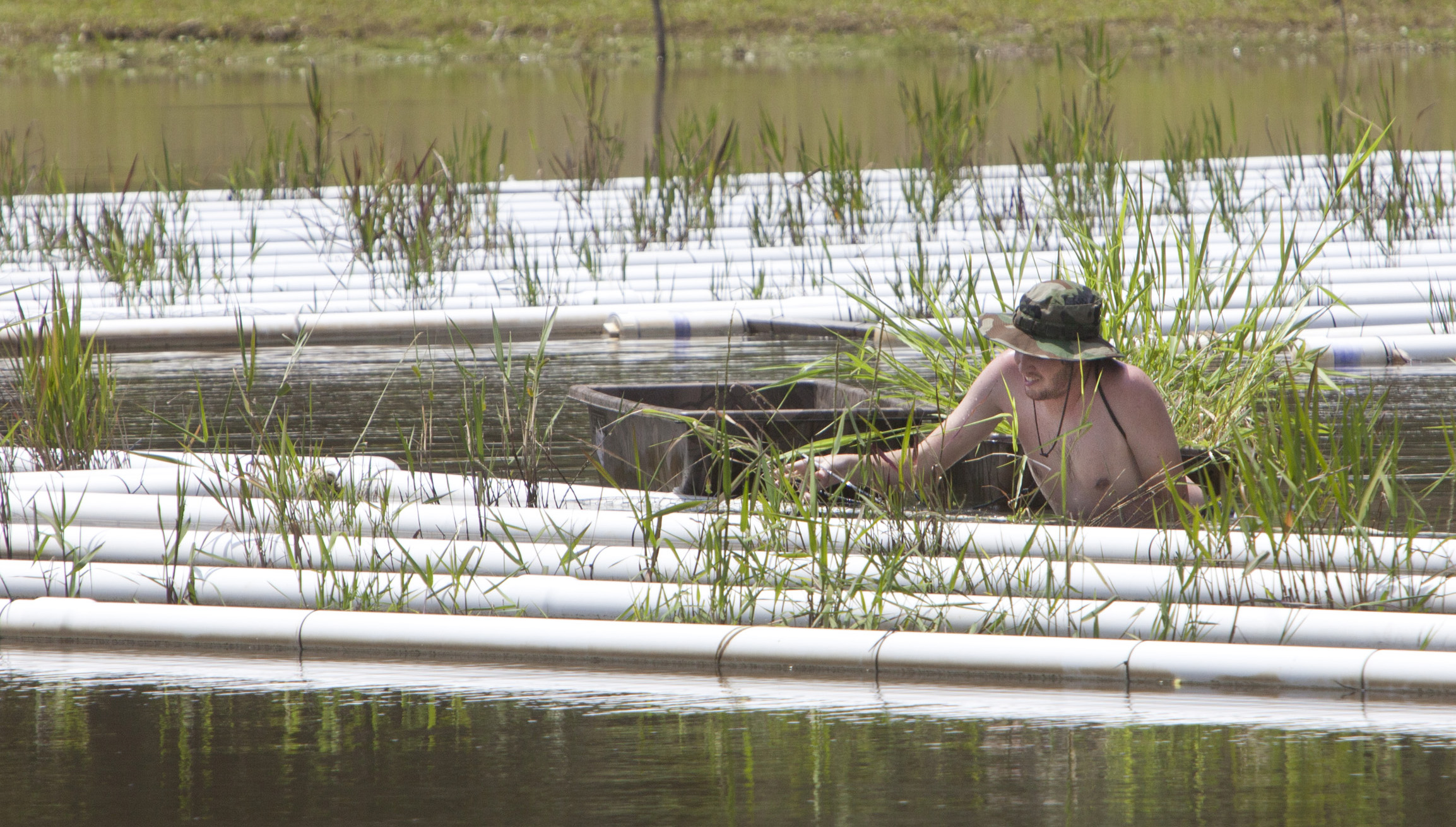Experimental floating marshland used to clean stormwater contamination
Published on by Naizam (Nai) Jaffer, Municipal Operations Manager (Water, Wastewater, Stormwater, Roads, & Parks)
 A relatively low-tech method of imitating a natural marshland was implemented to help clean freshwater ponds contaminated by stormwater runoff. This research is being funded by St. Tammany Parish Government in cooperation with scientists at Southeastern Louisiana University and the wetlands assimilation company Comite Resources, Inc.
A relatively low-tech method of imitating a natural marshland was implemented to help clean freshwater ponds contaminated by stormwater runoff. This research is being funded by St. Tammany Parish Government in cooperation with scientists at Southeastern Louisiana University and the wetlands assimilation company Comite Resources, Inc.
The effort is intended to improve water quality throughout St. Tammany through several water quality initiatives. Included is a project in the Del Sol subdivision of Covington that utilizes an innovative, yet relatively low-tech method of imitating a natural marshland that will help to clean freshwater ponds contaminated by stormwater runoff.
The $222,000 pilot project is a component of the newly initiated St. Tammany Parish stormwater management plan, a project that was launched to help the parish determine the most efficient and effective methods to retrofit other stormwater retention ponds, turning them into water quality enhancers, according to parish officials.
“Improving water quality and our environment in the parish are crucial,” said St. Tammany Parish President Pat Brister. “As we continue to research and implement the latest, most effective strategies to address pollution and stormwater runoff problems, we will continue to make great strides in improving the overall quality of our water throughout the entire community. Success will also make this pilot project replicable throughout St. Tammany and mimicked throughout the country.”
The project is being funded by the parish and implemented by Southeastern Louisiana University wetlands expert and Professor of Biological Sciences Gary Shaffer and graduate student Zach Leggett, who are working with Racheal Hunter of Comite Resources, Inc. based in Zachary, La.
Rainwater runoff enters the Del Sol pond from three directions, carrying with it sediment, oils, tar, fertilizers and herbicides that accumulate in the subdivision’s watershed and contaminate the pond.
Leggett and Shaffer are evaluating the cleaning effects of a man-made floating marsh in the eight-acre pond. Leggett’s hands-on project is the focus of his master’s thesis at Southeastern.
“The floating plants take out the excess nutrients and turbidity, or cloudiness, in the water, including fertilizers, pesticides, herbicides and other materials that can be harmful to water quality,” Leggett said.
In the fall, Leggett and his team constructed a star-shaped, eight-armed frame of PVC piping with four-foot wide vinyl coated crab wire between the piping that acts as a platform and serves as a supporting structure for marsh plants, such as maidencane, arrowhead and spider lily. The plants attached to the netting, serve as a natural filtering mechanisms for the pond water. The predominant water plant used in the structure is maidencane, an inexpensive plant that is easily propagated in the university’s greenhouses before being transplanted into the frame.
“The maidencane roots are full of gas, so the plants tend to float on top; this makes it ideal for this kind of structure,” explained Shaffer. “Maidencane is a good plant for this purpose; the roots grow about 20 inches deep and suck up the excess nutrients in the water and help clean the pond. As an added benefit, the structure also becomes a huge refuge for small fish and other species.”
While water quality tests are only in the early stages, Shaffer said the pond has become much clearer with a huge reduction in turbidity, or cloudiness. In addition, he said, the frames are full of minnows and juvenile fish, which greatly improves the ecosystem function of the pond.
“We expect the turbidity and nutrient levels at the site will be significantly reduced, which means we would be successful in our efforts to remove the contaminants and clear the water,” said Leggett. “And it would tell us whether maidencane is the ideal plant for this process.”
Hundreds of ponds in St. Tammany Parish are in need of water quality improvement, according to Parish officials. The Parish’s floating marshlands project, if successful, will play a significant and relatively inexpensive role in improving water quality. “
The research project and its final report are expected to be completed in 2017 after the plants have completely covered the platform.
Members of the Water Environment Federation, a not-for-profit technical and educational organization representing water quality professionals around the world, toured the natural marshland site in the Del Sol neighborhood on Tuesday (Sept. 27). The professionals were in New Orleans for the Water Environment Federation Technical Exhibition and Conference during the week of September 24-28, 2016, and visited the site to learn about best management practices that are being applied to existing stormwater ponds. Registrants who participated in the tour were from throughout the United States, as well as Singapore and Mexico.
Attached link
http://www.southeastern.edu/news_media/news_releases/2016/september/floating_marshland.htmlTaxonomy
- Stormwater Management
- Environment
- Stormwater
- Storm Water Management
- Stormwater Runoff